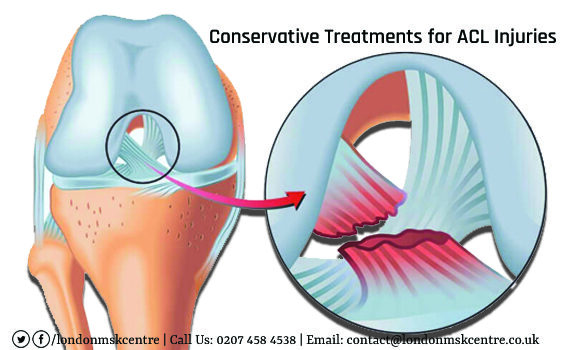
Conservative Treatments for ACL Injuries
ACL or Anterior cruciate ligament rupture is a common sports injury involving a sprain or tear. The ACL is a major ligament in the knee and injury occurs when you suddenly come to a stop or pivot to change the direction of your movement. An ACL injury can also occur from high jumping and hard landing. These movements are integral in sports like soccer, football, basketball and skiing.
Symptoms of ACL
There are many symptoms of an ACL injury, some more common than others. Here are the typical signs that indicate an ACL injury:
- A popping sensation in the knee
- Intense pain and immobility
- Fast swelling at the site of injury
- Loss of motion of more than one kind
- Instability during movements
Treatment Options
Typically orthopedic surgeons treat ACL injuries via surgery with the purpose of restoring joint stability. This helps patients return back to sports faster. Surgeries also prevent long-term degradation of joints and instability when moving. However, despite the wide practice of surgical reconstruction, records of recurrence of the key symptoms are pretty high in the first 2 years following surgery. This calls for alternative treatments that ensure sufficient improvements and a quick return to competency. Those treatments are referred to as conservative treatments.
Non-Surgical Options in Treatment
A surgery can be costly, not to mention painful and time consuming. If you are looking for non-invasive or conservative treatments, then here are alternative options:
Coper Identification Screening
Not all ACL injuries are the same. There are some that are mild and do not require extensive treatments. For these limited conservative treatments prove sufficient to return back to activity. Those patients are referred to as copers. There are some screening tests to identify a potential coper. These tests involve one-legged hopping, occurrence of the knee giving way under the weight of the body, functional test and global functioning of the knee joints. Should a patient pass said tests, then he or she is identified as a coper and is considered a candidate who can return back to activity with minimal treatment.
Physical Therapy
The most effective form of conservative treatment for ACL, this involves a set of daily exercises to improve the functions of the ligament and facilitate natural healing. A range of physical therapies are used to treat and restore the ligament, manage the pain and shorten the recovery period. These procedures are managed by specialists with extensive knowhow of MSK joints and physio therapies.
Modified Activity
The third option is obviously to modify one’s activities in order to preserve the motions of the knee and minimize the future chances of injuries. So if you are a sportsperson who is seeking a conservative form of treatment for ACL, your doctor may ask you to go easy on athletic activities, for at least some years. This will require you to cut down on activities that demand high stability. You may have to pick up a sedentary occupation for some time.










